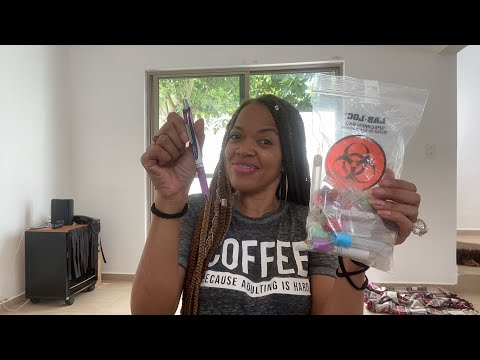The Many Roles of a Medical Assistant: Phlebotomy
Contents
- 1.What is phlebotomy?
- 2.The history of phlebotomy
- 3.How phlebotomy is used today
- 4.The training required to become a phlebotomist
- 5.The duties of a phlebotomist
- 6.The challenges of phlebotomy
- 7.The rewards of phlebotomy
- 8.Phlebotomy in the future
- 9.Frequently asked questions about phlebotomy
- 10.Additional resources for phlebotomy
Medical assistants play a vital role in patient care. They often perform many duties, including taking medical histories, scheduling appointments, drawing blood, and more.
Checkout this video:
1.What is phlebotomy?
1.Phlebotomy is the process of taking blood from a vein for testing or blood donation.
2.A phlebotomist is a medical assistant who specializes in this procedure.
3.The process begins with the insertion of a needle into the vein, which is then attached to a tube that collects the blood.
4.Once the blood has been collected, it is then sent to a laboratory for testing or to a blood bank for donation.
2.The history of phlebotomy
Phlebotomy is the ancient practice of drawing blood. The word “phlebotomy” comes from the Greek words “phlebo,” meaning “to cut,” and “tomy,” meaning “the act of cutting.”
The first recorded history of phlebotomy was in Egypt in 1600 BCE when doctors would make incisions in a patient’s veins to draw blood. This was done as a means of cleansing the body and was thought to be helpful in the treatment of various diseases.
The practice of phlebotomy continued throughout history and was used for both religious and medical purposes. In some cultures, bloodletting was thought to be a way to appease the gods or to bring good luck. In others, it was seen as a way to balance the body’s humors or to rid the body of toxins.
Medical drawings from the 16th century show people with diseases such as smallpox and leprosy being bled by physicians. In the 19th century, bloodletting fell out of favor as a medical treatment but continued to be used in some religious rituals.
The modern practice of phlebotomy began in the early 20th century when scientists developed new ways to study blood. They soon realized that drawing blood from people could be helpful in diagnosing and treating diseases.
Phlebotomy has since become an important part of medicine and is used for a variety of purposes, including:
-Drawing blood for laboratory tests
-Drawing blood for transfusions
-Donating blood
3.How phlebotomy is used today
Phlebotomy is a medical procedure where blood is drawn from a patient for diagnostic testing. A small needle is inserted into a vein in the arm and the blood is drawn into a vacuum-sealed tube. The tube is then labeled and sent to a lab for analysis.
Medical assistants often have training in phlebotomy, and it is their job to draw the blood from the patient and send it to the lab. Phlebotomy can be used to test for a variety of conditions, such as anemia, diabetes, and heart disease. It can also be used to screen for drug abuse or alcohol abuse.
4.The training required to become a phlebotomist
While there is no formal education required to become a phlebotomist, most employers will require some type of training. There are a number of ways to receive the necessary training, including certificate programs, associate’s degree programs, and on-the-job training. Many phlebotomists complete a certificate program that can be completed in as little as six weeks. These programs are typically offered through community colleges, technical schools, and hospitals. Associate’s degree programs in medical assisting also include coursework in phlebotomy, and may take two years to complete. Finally, some phlebotomists receive on-the-job training that can last several weeks or months.
5.The duties of a phlebotomist
The role of a phlebotomist is to draw blood from patients for various lab tests. Phlebotomists are an important part of the healthcare team. They work closely with patients, doctors, and nurses to ensure that patients are comfortable and that the blood is drawn correctly.
Phlebotomy technicians must be able to function in a fast-paced environment and have excellent communication skills. They must be able to understand and follow instructions carefully. They also need to be able to handle needles and other sharp objects safely.
6.The challenges of phlebotomy
While phlebotomy can be a relatively easy and routine task for a medical assistant there are still challenges that come with the job. One of the most difficult things about phlebotomy is dealing with patients who have a fear of needles. It can be hard to stay calm and reassuring when someone is visibly scared, but it’s important to remember that most people do not like needles and are justifiably scared of them.
Another challenge of phlebotomy is dealing with uncooperative patients. Some people simply do not want to have their blood drawn, no matter how much you try to explain that it’s necessary. In these cases, it’s important to be firm but polite. Remember that you are the medical professional and they are the patient.
Finally, one of the biggest challenges of phlebotomy is simply dealing with the sight of blood. For some people, blood doesn’t bother them at all. But for others, even seeing a small amount of blood can provoke an intense reaction ranging from lightheadedness to outright fainting. If you fall into this latter category, phlebotomy may not be the right medical field for you.
7.The rewards of phlebotomy
Blood work is essential for the diagnosis and treatment of many medical conditions. As a medical assistant you may be trained in phlebotomy, which is the process of drawing blood from patients.
Phlebotomy can be a rewarding career for those who are interested in working closely with patients and helping to improve their health. Medical assistants who are trained in phlebotomy can play an important role in the diagnosis and treatment of many medical conditions.
8.Phlebotomy in the future
Medical assistants perform a variety of duties in the medical office, including phlebotomy. Phlebotomy is the process of drawing blood from a patient for diagnostic purposes. It is a critical part of the diagnostic process and plays an important role in patient care.
As the healthcare industry continues to evolve, so does the role of the medical assistant Medical Assistants who are trained in phlebotomy will be in high demand in the future. With the advent of new technologies, phlebotomists will be needed to draw blood from patients using new techniques, such as venipuncture and fingersticks.
In addition, as the population ages, there will be a need for more medical assistants who are trained in phlebotomy to draw blood from elderly patients. This is because elderly patients are more likely to have chronic diseases that require regular blood testing.
So, if you are considering a career in medical assisting, be sure to get training in phlebotomy. It is a skill that will be in high demand in the future!
9.Frequently asked questions about phlebotomy
The job of a medical assistant is multi-faceted and demanding. They are responsible for a wide range of tasks in the medical office, from handling insurance paperwork and scheduling appointments to taking patient histories and performing routine laboratory tests. phlebotomy, or the act of drawing blood, is one of the most important responsibilities of a medical assistant.
Drawing blood can be a difficult and stressful task, both for the patient and the medical assistant. There are a lot of questions that frequently come up about phlebotomy, so we’ve compiled a list of the most commonly asked questions to help take some of the stress out of the process.
1. What is phlebotomy?
2. What are the responsibilities of a phlebotomist?
3. How do I become a phlebotomist?
4. What type of training do I need to become a phlebotomist?
5. How much does it cost to become a phlebotomist?
6. How long does it take to become a phlebotomist?
7. What are the benefits of becoming a phlebotomist?
8. What are some challenges I may face as a phlebotomist?
9. What are some common misconceptions about phlebotomy?
10.Additional resources for phlebotomy
There are a number of additional resources available for phlebotomy students and professionals. The National Phlebotomy Association (NPA) offers a variety of resources, including certification, continuing education, and job listings. The American Society for Clinical Pathology (ASCP) also offers certification and continuing education for phlebotomists. In addition, the Centers for Disease Control and Prevention (CDC) provides information on bloodborne pathogens and other safety concerns for phlebotomists.







